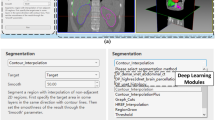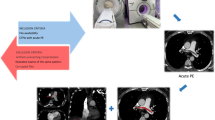Abstract
Recently, there has been a significant rise in research and development focused on deep learning (DL) models within healthcare. This trend arises from the availability of extensive medical imaging data and notable advances in graphics processing unit (GPU) computational capabilities. Trained DL models show promise in supporting clinicians with tasks like image segmentation and classification. However, advancement of these models into clinical validation remains limited due to two key factors. Firstly, DL models are trained on off-premises environments by DL experts using Unix-like operating systems (OS). These systems rely on multiple libraries and third-party components, demanding complex installations. Secondly, the absence of a user-friendly graphical interface for model outputs complicates validation by clinicians. Here, we introduce a conceptual Computer-Aided Detection (CAD) pipeline designed to address these two issues and enable non-AI experts, such as clinicians, to use trained DL models offline in Windows OS. The pipeline divides tasks between DL experts and clinicians, where experts handle model development, training, inference mechanisms, Grayscale Softcopy Presentation State (GSPS) objects creation, and containerization for deployment. The clinicians execute a simple script to install necessary software and dependencies. Hence, they can use a universal image viewer to analyze results generated by the models. This paper illustrates the pipeline's effectiveness through a case study on pulmonary embolism detection, showcasing successful deployment on a local workstation by an in-house radiologist. By simplifying model deployment and making it accessible to non-AI experts, this CAD pipeline bridges the gap between technical development and practical application, promising broader healthcare applications.
Access this chapter
Tax calculation will be finalised at checkout
Purchases are for personal use only
Similar content being viewed by others
References
Esteva, A., et al.: A guide to deep learning in healthcare. Nat. Med. 25, 24–29 (2019). https://doi.org/10.1038/s41591-018-0316-z
UNSCEAR 2020/2021 Report Volume I. www.unscear.org/unscear/en/publications/2020_2021_1.html. Accessed 18 Sept 2023
Dally, W.J., Keckler, S.W., Kirk, D.B.: Evolution of the graphics processing unit (GPU). IEEE Micro 41, 42–51 (2021). https://doi.org/10.1109/MM.2021.3113475
Kahraman, A.T., Fröding, T., Toumpanakis, D., Gustafsson, C.J., Sjöblom, T.: Deep learning based segmentation for pulmonary embolism detection in real-world CT Angiography: classification performance (2023). https://doi.org/10.1101/2023.04.21.23288861v2. https://doi.org/10.1101/2023.04.21.23288861
Esteva, A., et al.: Dermatologist-level classification of skin cancer with deep neural networks. Nature 542, 115–118 (2017). https://doi.org/10.1038/nature21056
Nyarko, K., Taiwo, P., Duru, C., Masa-Ibi, E.: AI/ML systems engineering workbench framework. In: 2023 57th Annual Conference on Information Sciences and Systems (CISS), pp. 1–5 (2023). https://doi.org/10.1109/CISS56502.2023.10089781
Newaz, A.I., Sikder, A.K., Rahman, M.A., Uluagac, A.S.: A survey on security and privacy issues in modern healthcare systems: attacks and defenses. ACM Trans. Comput. Healthcare 2, 27:1–27:44 (2021). https://doi.org/10.1145/3453176
Author information
Authors and Affiliations
Corresponding author
Editor information
Editors and Affiliations
Rights and permissions
Copyright information
© 2024 The Author(s), under exclusive license to Springer Nature Switzerland AG
About this paper
Cite this paper
Kahraman, A.T., Fröding, T., Toumpanakis, D., Fridenfalk, M., Gustafsson, C.J., Sjöblom, T. (2024). A Simple End-to-End Computer-Aided Detection Pipeline for Trained Deep Learning Models. In: Kofroň, J., Margaria, T., Seceleanu, C. (eds) Engineering of Computer-Based Systems. ECBS 2023. Lecture Notes in Computer Science, vol 14390. Springer, Cham. https://doi.org/10.1007/978-3-031-49252-5_23
Download citation
DOI: https://doi.org/10.1007/978-3-031-49252-5_23
Published:
Publisher Name: Springer, Cham
Print ISBN: 978-3-031-49251-8
Online ISBN: 978-3-031-49252-5
eBook Packages: Computer ScienceComputer Science (R0)




